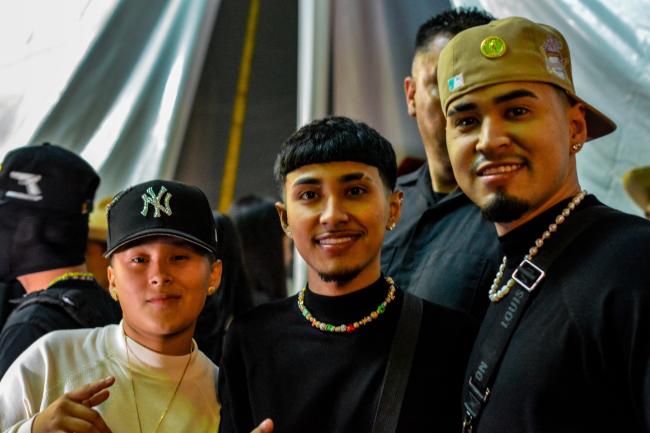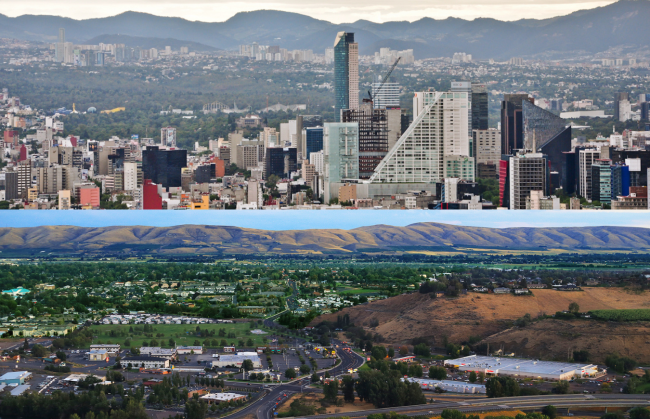
“No eres de aquí, verdad?” (You’re not from here, are you?) Growing up, I had a different answer to this question every time I returned to Mexico as the number of seasons between my temporary visits grew longer and longer. I moved to the United States at a young age and my Mexican parents enforced a Spanish-speaking household, but there was simply no way of circumventing the fact that our daily life was carried out in English.
In January 2023, the Washington state-based music trio of Mexican heritage Yahritza y su Esencia was interviewed by Soy Grupero, a Mexican channel covering regional Mexican music. The three artist and siblings, Yahritza, Armando, and Jairo Martinez, are seated in a row of chairs, leaning forward eagerly as the interviewer poses questions offscreen. They clearly look like Mexican youth; their excitement is visible and their Spanish is peppered with English words or phrases. I can immediately relate, especially when it takes one of them a few seconds to remember the exact Spanish word to use. When asked about their time in the Mexican capital, the artists demonstrated their genuine culture shock at being in the second largest city in the Americas. “I do like [Mexico City] but I don’t like waking up to the sounds of all the sirens and the police and all of that,” Yahritza said in Spanish.
Like Yahritza and her siblings, subtle inflections in my spoken Spanish gave me away immediately to Mexican residents. It only made things more confusing that I grew up with a Mexico City accent in my early childhood followed by a norteño one before my teens. Even when I was back in Mexico for long stretches of summer and started dreaming in Spanish again, my inability to keep up with the slang in the northern and central parts of the country showed that I was susceptible to not being fully Mexican or labeled as the one who preferred life in the “gabacho,” outside the country.
One of the comments that drew the most social media ire against Yahritza y su Esencia was when Jairo commented on Mexican cuisine. “For me it’s also about the food, I’m very delicate and I only eat chicken… like wings without chili, I don’t like any of that stuff,” Jairo said in Spanish, but articulating the word “chicken” in English.
The group was immediately ridiculed on social media for “not being Mexican enough.”
Mexico City can be a distorting experience for anyone who hasn’t grown up in a bustling metropolis. I believe Mexican cuisine is among the best in the world, but the trio’s home is Yakima County, a place where 52 percent of the population is Hispanic or Latino and where tens of thousands of Mexicans live. Taking into account the geographical, cultural, and culinary differences between Yakima County and Mexico City, it’s understandable that the trio felt overwhelmed by the cascade of sensations.
The Backlash
Last year when lead vocalist Yahritza was only 15, the group came in at number 20 on Billboard’s Hot 100 Chart for their single hit “Soy El Único,” a testament to their popularity in the United States. At the 23rd Annual Latin Grammy Awards, the trio was nominated for Best New Artist as well as for Best Norteño Album for their debut album, Obsessed.
Despite their success and popularity, the siblings became an easy target for digital vitriol due to their uneven grasp of the Spanish language and inclination for non-spicy foods. It’s something I’ve felt before to varying degrees. I was often confused about the latest slang in Spanish, constantly asking what things mean. In my younger years, I admit that I knew more about American revolutionary history than the Mexican independence movement. I was anxious about having to prove to others and to myself that I was, indeed, Mexican.
The judgment the musical trio was subjected to went beyond online attacks. Piñatería Ramírez, a popular store known for its thematic piñatas, depicted the artists in Indigenous attire with cactus branches on their faces, a nod to the racist phrase “con el nopal en la frente,” meaning that one has Indigenous features. The nopal cactus is a symbol of historical importance to the Aztecs, the civilization that originally settled in what is now Mexico City upon finding an eagle devouring a snake on a cactus. When used in reference to someone’s features, “nopal en la frente” often has derogatory connotations. On social media the siblings were called “grindios”, a portmanteau of “gringo” and “indio,” a clear example of Mexican society denigrating individuals based on perceived nationality and physical appearance.
The backlash went as high as the Mexican presidential office, prompting President Andrés Manuel López Obrador (AMLO) to speak out in their defense. During a press conference on August 31 AMLO, noted that the band had been “punished” when they had not meant to offend or act in bad faith.
“We can’t act with intolerance. We have to forgive. They’re children and there’s an explanation: they were born over there. Their parents were born here but they grew up over there,” the president said, proceeding to invite the group to perform at the Zócalo for Mexico’s independence day celebrations.
Why does discrimination against pochos—a term used in Mexico to refer to Mexican Americans and Mexican migrants—remain so entrenched? The narrative that there are Mexicans who aren’t quite Mexican is a reflection of the inherent contradictions in the way Mexico wants to see itself—proud of its nationality, yet ashamed to have Indigenous roots; admiring its people for speaking other languages while dismissing its own native languages at home.
In a 2021 UNICEF survey, approximately 40 percent of Mexican children aged three to nine reported experiencing discrimination related to factors such as skin color, height, age, or weight. Indigenous and darker-skinned Mexicans feel the brunt of racism and classism in Mexico, two forms of discrimination that are inevitably linked and date back to the colonial structures of the caste system. According to data from the National Commission on Minimum Wages published in June 2022, working Mexicans who belong to any of the 68 Indigenous groups in the country earn on average 18 percent less than non-Indigenous Mexicans.
It was disappointing when people called the trio “pochos,” perpetuating a term that erases the nuances and complexities of the experience of immigrants and individuals born to immigrant parents.
Mexicans in the United States use Spanish and English—and often a mix of both of them—in our daily lives, code-switching when we need to accommodate others. To poke fun at Yahritza y su Esencia for mixing languages is to dismiss the colloquial expressions employed by over 37 million people.

Reclaiming the Word “Pocho”
Some Mexicans living in Mexico might argue that “pocho” isn’t a slur but rather a term of endearment, or a nickname at worst. But that thinking disregards the historical reality that “pocho” has been used to indicate that one doesn’t belong. We can, however, repurpose the term and its meaning as migration between Mexico and the United States continues to be a dynamic force at the forefront of their relationship.
Individuals familiar with the experience of living in and outside of Mexico invite us to view Mexicanness through a prism with which we can see the incredible, lively, and ever-changing range of Mexicanness within and beyond the made-up borders of the nation.
The nonprofit Otros Dreams en Acción (ODA) was created by people who grew up in the United States and now find themselves in Mexico due to deportation or other policy issues, and now devote themselves to providing support and political advocacy for others in a similar situation. In January 2018, ODA founded Pocha House as part of an effort to reappropriate the word and provide a space for individuals who have been cast into the nexus of immigration processes and cultural and linguistic differences. Located in a building in the Roma borough of Mexico City, Pocha House provides a communal space for gatherings that include educational activities like English lessons, art workshops, and more.
Esmeralda Flores, an ODA member, originally intended to study in a U.S. university but because she was unable to access financial aid as an undocumented student, she was asked to return to Mexico to obtain a student visa with the help of a sponsor. Though she found one, the sponsor in question fell through and her case for a student visa was undone. Unable to return to the United States, Flores enrolled in law school at the National Autonomous University of Mexico (UNAM). Flores, who says she’s white-passing, experienced cultural shock in the weeks and months she spent remaking a home in her native country.
Flores described “incidents” and “backhanded compliments.” “I do remember that for people who had recently met me and weren’t necessarily my friends… it would shock them that I would talk about the U.S. or say things in English with [good] pronunciation in English… I was called a ‘mamona’ [a snob],” Flores recounts about her return to Mexico.

Guadalupe Chavez, another ODA representative and a doctoral candidate at the University of Oxford, hails from New York, where standard Mexican Spanish is just one among dozens of different versions of the same tongue.
“There’s a big difference growing up as a Mexican American on the East Coast versus the Southwest or the West Coast—the concept of ‘pocha’ was just something that I was never aware of until I decided to read more work on the Chicano movement in the literature,” Chavez said.
The ability to travel between the United States and Mexico, however, did not make Chavez immune to unfair assumptions. Chavez’s friends in New York praised her Spanish, but in certain spaces in Mexico people would single her out for having a different accent.
Skin color plays a historic role in how Mexican society perceives itself and others. The majority of the Mexican elite is white, from government to media to business. Mexican Americans who are of darker skin tone than their white counterparts are subjected to insults like “tienes el nopal en la cara,” which is also meant to derogate Indigenous phenotypes from the often ironic remark of “qué güero eres” (“how fair-skinned you are”).
Alejandro González Iñrritu’s 2022 film Bardo, captures these contradictions movingly in his depiction of a Mexican-born journalist working between his home in the United States and his native country. In a scene in which his family is passing through Dulles International Airport in Washington D.C., a brown-skinned customs officer of Latino heritage chastises the protagonist, Silverio Gacho, and his son, saying they cannot call the United States their “home” as they’re not citizens, but rather temporary visa holders. Gacho’s son and daughter single out the officer, saying he “looks more Mexican than I do” in Spanish, to which the officer nonchalantly replies that he is “American” and doesn’t speak Spanish.
Return Migration
Flores believes that much of the discrimination against pochos comes from an unwitting ignorance from not understanding the causes and bureaucratic nightmares of return migration, when migrants are forced to return to their native country for voluntary or involuntary reasons. At Pocha House, Flores aims to “put a face on these migration numbers” and show that while both the United States and Mexican systems label people as migrants, they’re also artists, lawyers, and so much more.
Return migration is not something discussed in most Mexican households. Flores describes what it’s like for people to bring it up with their families. Tíos and tías, or aunts and uncles, “don’t understand.” “It’s painful that [our family will] never understand because they’ve never been through anything we have,” she says. “They haven’t been exiled from a place we’ve called home, even if they’ve been marginalized too.”
Physical appearance also remains a way for Mexicans to place themselves and others in certain boxes. An academic researcher at the University of Oxford, Chavez still finds herself having to explain herself to people in Mexico that she speaks English and has studied at the university level.
“Is it because of the way I look, that I’m a darker-skinned Mexican American that they think that I can’t be in those spaces?” she asks. For Chavez, there is something “embedded” deeply within Mexican society that has perpetuated oppressive and racist notions of what it means to be Mexican depending on the color of one’s skin or background. Groups like ODA and gatherings at Pocha House aim to question and resist these prevailing narratives and offer more nuanced expression to the human experience at the center of dynamics of identity, return, and belonging.
The Power of Heritage in Music
In a September interview with The Seattle Times, Armando described how the backlash was indicative of a larger issue that has yet to make headway in Mexico.
“I feel like nobody really understands how a Mexican American’s life is, because when you come over here, you get criticized when you go to school for talking Spanish,” Armando said. “So, you go to Mexico and you’re already 15,16 or 20 years old… and people criticize you for not speaking Spanish. It’s like, where am I from?”
Armando said the flak from their Mexico tour was “definitely a lesson learned,” and his sister Yahritza said the chapter had been “heartbreaking.” It should also be the same for Mexicans.
In recent years I’ve come to embrace a fluid identity, where I’m from here and from there, where my Mexicanness isn’t determined by an extraneous entity nor by my spoken Spanish, but rather by the ties I choose to nurture and grow with the larger number of communities I’m able to connect and engage with. The music of Yahritza y su Esencia is a testament to that expansive view.
Humberto J. Rocha is a reporter currently covering the European carbon markets and a freelancer focusing on politics and culture in Latin America. A Mexico City native and a Harvard and Oxford graduate, Humberto writes for local, national, and international outlets.

